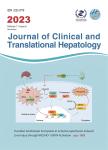Interaction Between the Neglected Tropical Disease Human Schistosomiasis and HCV Infection in Egypt:a Puzzling Relationship
Interaction Between the Neglected Tropical Disease Human Schistosomiasis and HCV Infection in Egypt:a Puzzling Relationship作者机构:Immunology and Infectious Diseases Group Therapeutic Chemistry Department the Centre of Excellence for Advanced Sciences the National Research Centre Dokki Cairo Egypt Research Group of Biomarkers for Infection and Immunity Institute of Experimental Infection Research TWINCORE Centre for Experimental and Clinical Infection Research Hannover Germany
出 版 物:《Journal of Clinical and Translational Hepatology》 (临床与转化肝病杂志(英文版))
年 卷 期:2014年第2卷第2期
页 面:134-141页
学科分类:1004[医学-公共卫生与预防医学(可授医学、理学学位)] 1002[医学-临床医学] 100401[医学-流行病与卫生统计学] 10[医学]
主 题:Egypt Neglected tropical disease Human schistosomiasis HCV Coinfection Immune evasion mechanisms HCV protease Schistosome pro-teases
摘 要:Egypt has the highest prevalence of chronic hepatitis C virus (HCV) infection and seropositivity worldwide, and it has been proposed that this enhanced susceptibility to HCV is related to coinfection with schistosomiasis. Although currently, there are no studies regarding the actual prevalence of both human schistosomiasis and schistosomiasis/HCV coinfection evi-dences strongly support that eliminating human schistoso-miasis from Egypt is necessary to reduce both HCV prevalence and liver pathology. The present review highlights the significant impact of the neglected tropical disease human schistosomiasis on both susceptibility of Egyptians to HCV coinfection, severity of the resulting liver pathology, and poor response to antiviral therapy. The immune evasion mechan-isms exerted by the HCV-NS3/4A protease domain, and the possible impact of immune evasion mechanisms exerted by proteases of larval, worm and egg stages of the parasite Schistosoma on human susceptibility to HCV infection are discussed. In addition, schistosome immune evasion mechanisms may include immunosuppression that in turn prevents clearance of HCV viremia and leads to relapsing HCV infection and severe liver pathology. I propose the generation of a replicon system from the most prevailing genotype (HCV-4a) in Egypt and establishing its replication on hepatoplas-toma or immune cells in presence of bilharzial antigens. Finally, the use of a humanized small animal model that can acquire both HCV and S. mansoni infections will be important to further understand in real time the impact of coinfection on both the immune system and liver pathology.



